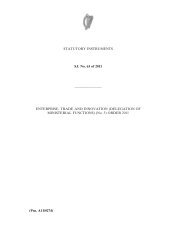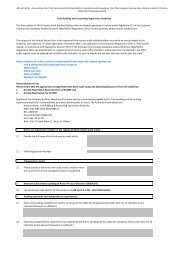View - Esma
View - Esma
View - Esma
You also want an ePaper? Increase the reach of your titles
YUMPU automatically turns print PDFs into web optimized ePapers that Google loves.
a. The activities of the SPE are conducted on behalf of the issuer according to its specific business needsso that the entity obtains benefits from the SPE’s operation;b. The SPE is an “auto-pilot” and all the management decisions are clearly established in the contractwith the issuer;c. The issuer has rights to obtain the majority of the benefits of the SPE and therefore may be exposed torisks incidental to the activities of the SPE; ord. The entity retains the majority of the residual risks related to the SPE or its assets in order to obtainbenefits from its activities.Further support for consolidation of the SPE was also provided by consideration of the factors listed in theAppendix to the Interpretation; specifically the fact that the SPE’s activities are, in substance, being conductedon behalf of the reporting entity as the SPE is principally engaged in providing a source of long term capital toan entity to support the issuer’s major or central operations and the SPE supplies goods or services consistentwith an entity’s ongoing major or central operations which, without the existence of the SPE, would have to beprovided by the entity itself.The enforcer considered that the transfer of current trade receivables arising from the core business providesthe necessary liquidity to support the issuer’s ongoing central operations.The fund is over collateralized by the transfer of receivables with a nominal value of approximately 170million euros, when the finance line is just 140 million. The difference between the payment of senior notes(interest rate of EURIBOR for one month deposits plus a spread, plus the amortization of 140 million) and theresidual amount existing in the fund is returned to the issuer through (i) the payment of the deferred priceunder the receivables agreement and (ii) through the payment of the nominal value of the junior notes, plus a5% interest.In substance, the issuer is exposed to the majority of the risks and rewards of the SPE’s assets once thefollowing factors are viewed together:a. The receivables are of short maturity;b. The issuer would like to retain the 140 million euros as a finance line until 2011 and, for thatreason, will use the option to replace any defaulted receivables, if they exist (call option), andc. The probability of default of payment on the senior notes is very low.* * *Decision ref.EECS/0508-04: Application of the pooling of interest method in a business combination undercommon controlPeriod end: 31 December 2007 /ProspectusCategory of issue: Business CombinationStandard involved: IFRS 3Date of the decision: 10 May 2007Description of the issuer’s accounting treatmentIn December 2007, M (a parent company) reorganized its subsidiaries. M transferred to A (the issuer) itsownership interests in B and C as well as part of its own activities. In exchange, M received additional sharesfrom A, leaving the existing minority interests unchanged (but reducing their significance).As the companies and activities transferred to the issuer were under common control, as defined in paragraph3 of IFRS 3, the issuer was not required to apply that standard to the accounting for the business combination.In the absence of any specific standard prescribing how to account for this kind of transaction, the issuerfollowed the requirements of IAS 8. This standard, at paragraphs 8-10, allows management to consider theapplicability of pronouncements of other standard-setting bodies when developing and applying anaccounting policy in respect of areas not covered by a specific requirement within IFRS. The issuer decided toapply the accounting treatment required by the US Statement of Financial Accounting Standard (SFAS) 141 asset out below.FAS 141 requires the transfer of net assets or exchanges of shares between entities under common control tobe treated as follows:- The entity that receives the net assets should initially recognize the assets and liabilities transferred attheir carrying amounts (in practice, many entities use a method similar to that of the poolingmethod).- 6 -










